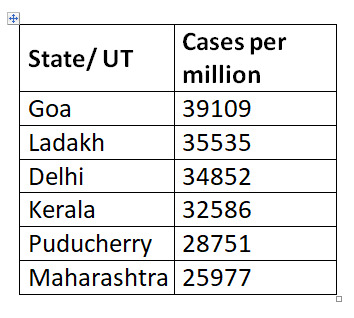
views
Recently, we are witnessing a countrywide second wave of COVID-19 infections, which is more fierce and worrisome in Maharashtra. If we have a cursory look at the day-to-day figures of positive cases, Maharashtra is definitely reporting the highest number of cases across the country. Maharashtra’s contribution to overall morbidity and mortality due to COVID-19 is significant among all other states in the country. Of the 1.29 crore COVID-19 cases reported across the country, Maharashtra’s contribution stands at almost 32 lakh. Every fourth COVID-19 infected person is from Maharashtra.
This raises an obvious question: Why is Maharashtra the worst-affected state? Lowering down of guard by people, in terms of not following COVID appropriate behaviour or unnecessary crowding, can be seen everywhere and not just Maharashtra. Then, why is only Maharashtra posting such large number of COVID-19 cases?
Population and Urbanization
We need to solve this riddle step by step by looking at various aspects of epidemiology. The first obvious reason for Maharashtra’s large numbers is its population size. Maharashtra is the second-most populous state of India after Uttar Pradesh. So, it is expected that Maharashtra would have more cases proportionate to its population size. But actually, Maharashtra is reporting more cases than that. Another question then would be—Why is Uttar Pradesh reporting fewer cases compared to Maharashtra, despite being the most populous state?
Reasons need to be searched. Duane Gubler, an expert on dengue, in his paper ‘Dengue, Urbanization, and Globalisation – Unholy Trinity of 21st Century’, argues that urbanization is one of the key factors driving the emergence of the epidemic dengue. The same is true for COVID-19.
ALSO READ| Next Four Weeks Crucial in India’s COVID Fight. Country Must Act on These Five Points Now
We are observing that COVID-19 is more or less an urban phenomenon. More than half of the COVID-19 cases in Maharashtra are being reported from four major cities, Mumbai, Thane, Pune and Nagpur. It categorically explains that the extent of urbanization in any community is one of the important determinants for COVID-19 morbidity. Maharashtra is one of the most urbanized (more than 50 per cent) states of India. The scale of urbanization in Maharashtra is comparable only to Kerala and Tamil Nadu. UP, Maharashtra, Bihar, West Bengal and Madhya Pradesh are the five most populous states, but the proportion of urbanization in UP and Bihar is 22 and 11 per cent, respectively. Nearly 70 per cent of the population in Madhya Pradesh and West Bengal is located in rural areas. This demographic profile has a major impact on the COVID-19 transmission dynamics.
Globally, we are observing that most developed and urbanized countries are reporting more COVID-19 cases. More developed states like Maharashtra also act as migration magnets, attracting people from other states for education and jobs. A comparison between Delhi and Uttar Pradesh can further explain this point. Although Delhi-NCR has a population of nearly 3 crore, almost one-ninth of the total population of Uttar Pradesh, it is reporting more cases than the most populous state in India. Only urbanization and high population density can explain this apparently skewed picture.
We need to look at data from a different angle to understand it better. Many a times, the absolute number of cases will not give us the true picture, but cases per million will better point to the scale of COVID-19 spread in that particular state or Union Territory. If we look at total cases per million, then states like Goa, Delhi and Kerala have more cases than Maharashtra.

This explains that there are other states and Union Territories which are equally or more affected by the virus spread than Maharashtra. We need to understand that urbanization is not a standalone phenomenon. It includes industrialization, rampant migration, the issue of affordable housing, and providing essential services to an ever-growing urban population.
Expansion of the public health infrastructure in urban localities cannot keep pace with the population growth. We have at least adequate public health infrastructure in rural India, thanks to the Bhore committee recommendations in the 1940s. But the National Urban Health Mission (NUHM), in comparison, is a relatively new initiative. Maharashtra has 27 municipal corporations and nearly 400 municipal councils. Providing essential primary healthcare to its urban population is the real challenge for developed states like Maharashtra. We cannot ignore that all these factors have their impact on COVID-19 epidemiology.
Efficient Surveillance System
Any state with an efficient and sensitive surveillance system in place will detect more cases during an epidemic. If we go by last decade’s data on swine flu and dengue, Maharashtra has always reported the highest number of cases. We all know about Kerala’s public health track record. Its vital health indicators like infant mortality rate and maternal mortality rate are comparable to many developed countries.
ALSO READ| The Curious Case of Maharashtra: Why It Is So Vulnerable to Surges of COVID Infections
Although population-wise, it is ranked 13th in the country, due to effective and transparent surveillance, it has reported the second-highest cases of COVID-19 in the country. The population size of UP is almost three times that of Kerala, but still Kerala has reported nearly double the cases. In scientific language, it is called ‘reporting bias’. We need to comprehend this while analysing COVID-19 data.
Obviously, viral mutations are much discussed. They are the driving force of transmission to some extent. We are yet to understand the exact role of the weather pattern in COVID-19 transmission. We need to look at the entire community or state to understand its disease epidemiology; mere data is meaningless unless we convert it into comprehensive information and knowledge. The pandemic waves are washing out our banks of economic and social prosperity. We need to read the writing on the wall. You can deal with data the way you want but data is not of any worth if it doesn’t lead to informed action. We need to devote the coming decade to public health, with more focus on urban localities. The message is loud and clear if anyone wants to listen.
Read all the Latest News, Breaking News and Coronavirus News here. Follow us on Facebook, Twitter and Telegram.














Comments
0 comment